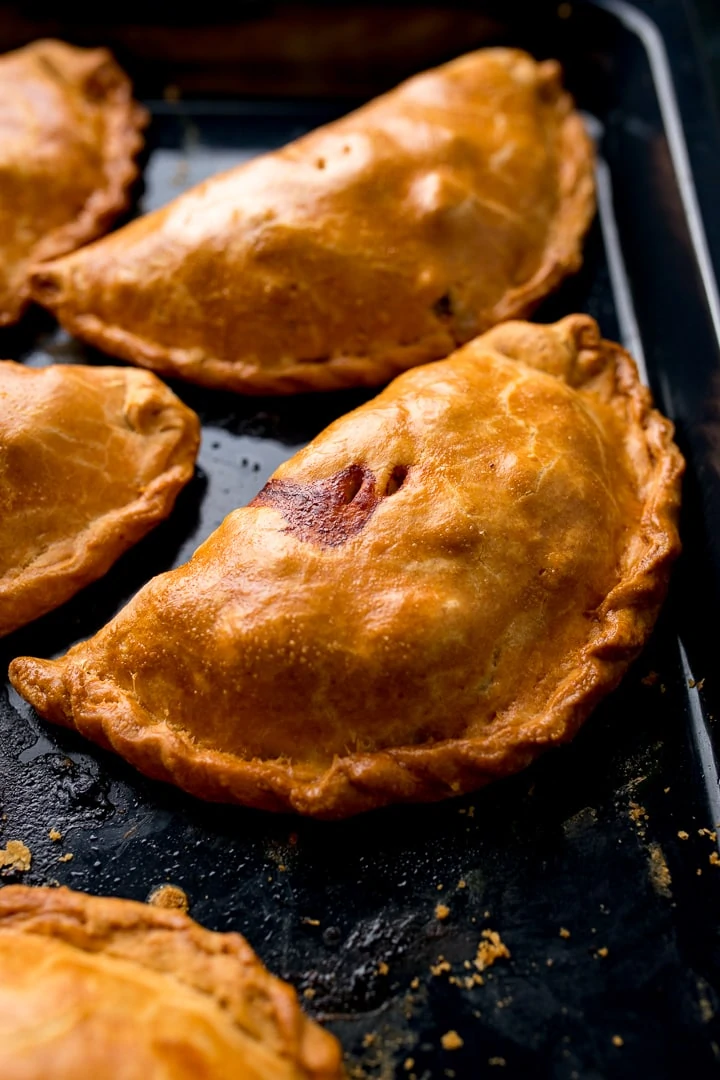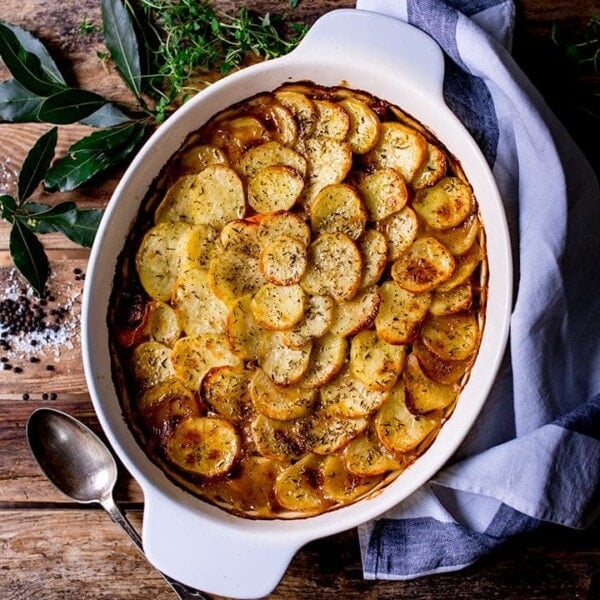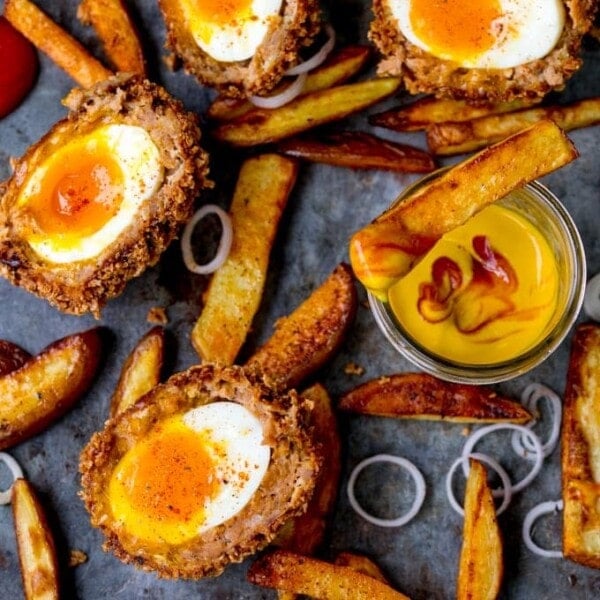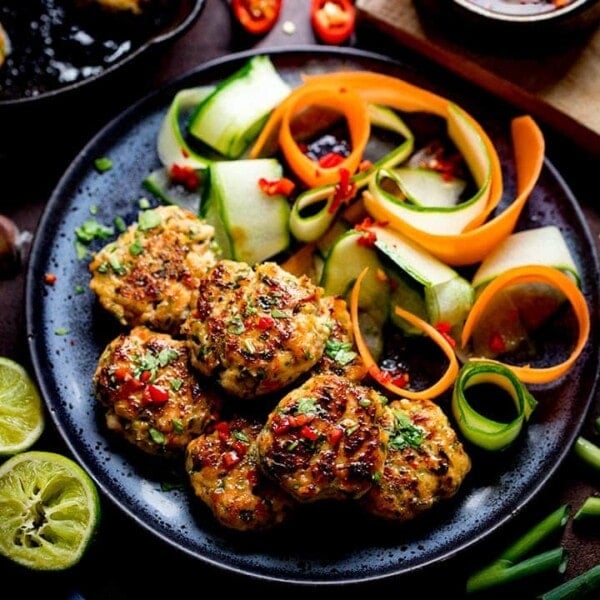Cornish Pasties with tender peppery chunks of beef mixed with melt-in-your-mouth vegetables, all wrapped up in buttery golden pastry. The Cornish Pasty is one of the most famous foods to come out of the south of England, and I can completely understand why the Cornish folk have so much pride in this tasty hand-held meal.

We love visiting Cornwall and often take little trips down south to wander around beautiful little coastal towns.
We often eat a fair few Cornish pasties when we’re there.
In fact Gracey shockingly announced on one occasion that she’d rather have a Cornish pastie than an ice cream!
She was delighted when I told her I’d teach her how to make them.
The Cornish pasty goes back hundreds of years, but they’re most commonly known to have been a staple food of the poorer classes going back to the 18th century. Miners used to take the pasties into the tin mines, and they’d be nutritious and filling enough to keep the workers going all day.
The specific shape of the pastie was thought to have come around for good reason too.
The crimped crust on the side was used as a kind of handle. The levels of arsenic in the tin mines meant that the miners hands would be grubby and likely covered in this highly toxic substance. So the miners would hold onto the crust to eat their pastie, and then discard it.
Personally I love the crust, but I think I could be persuaded to chuck it away if it was covered in arsenic!!

These Cornish Pasties are filled with a mixture of well-seasoned steak, onions, potatoes and swede (or rutabaga/yellow turnip if you’re in the US). The meat and vegetables are placed in the pastry raw, with a really good pinch of salt and pepper and a few dots of butter, then sealed and cooked in the pastry. There’s no sauce inside a Cornish pasty, but the cooked filling ends up so tender and moist that it’s not needed.
What do we need

How to make the shortcrust pastry
This is a basic shortcrust pastry, so you can replace with shop-bought if you prefer.
- Place flour, baking powder and salt into a food processor and give a quick mix.
- Add in cubed butter and whizz until the mixture turns into breadcrumbs.
- Add in egg yolks and mix, then, with the motor on, add in water a bit at a time until the dough comes together into a ball.
- Wrap the pastry in clingfilm or wax paper (<– affiliate link) and refrigerate for an hour.
- Roll out the pastry and cut circles into the dough using a side plate as a template.

Making the pasties
Full ingredients, quantities, timings and temperatures in the recipe card at the bottom of the post.
- Mix cubed potato, swede/rutagaba, onion, steak, salt and pepper in a large bowl.
- Place a really good handful of the mixture onto on side of one of the pastry circles and dot a little butter on top.
- Brush egg wash around the edge of the pastry circle and fold the other side of the pastry over the meat until the edges meet and you have a semi-circle.
- Seal firmly and crimp with your fingers (check out my video below to see how to do this).
- Make a little hole in the top of the pasty using a sharp knife to let out the steam. Repeat with the remaining pasties and then brush egg wash over the top of all the pasties.

Bake for 50 minutes until golden brown.

You mean you add the meat raw?
Yes! We’re using a good quality cut of beef, so it only needs the light cooking inside the pasty. The juices that are released from the meat during cooking will flavour the veggies and make the filling lovely and juicy.
The best cut of beef for Cornish Pasties
Skirt steak, sirloin or ribeye are the best cuts for the most tender and juicy meat for a Cornish pasty filling.
Note: skirt steak can be a little on the tough side, but small pieces that have been cut against the grain will still be plenty tender enough.
Don’t be tempted to use braising/chuck/stewing beef or the meat will be chewy and tough.
Why don’t they have any sauce/gravy?
The cooking of the meat releases lovely flavoured juices in the pasty. A gravy just isn’t needed!
Besides, ketchup for dipping is a MUST for a Cornish pasty. Well, that’s my opinion anyway.
More Picnic Ideas
Making these as part of a picnic? Here are some more picnic ideas
- French pressed sandwich bites
- Coronation Chicken
- Chorizo Scotch Eggs
- Chicken and Chorizo Puff Pastry Rolls
- Creamy Potato Salad
- Tear and Share Sausage Rolls (or Vegetarian Sausage Rolls)
- Salted Caramel Millionaires Shortbread
- Banana Bread Energy Balls
The Recipe Video:


Cornish Pasties
Ingredients
Pastry:
- 450 g (3 2/3 cups) plain (all-purpose) flour plus a couple of tbsp extra for rolling out the pastry and sprinkling on the tray later
- 2 tsp baking powder
- 1 tsp salt
- 125 g (1/2 cup + 1 tsp) unsalted butter chopped into chunks
- 2 egg yolks
- 125 ml (1/2 cup + 1 tsp) cold water
Filling:
- 450 g (1 lb) potato peeled and finely diced
- 150 g (1/3 lb) swede/rutagaba peeled and finely diced
- 150 g (1/3 lb) onion peeled and finely chopped
- 300 g (2/3 lb) skirt steak or sirloin steak finely chopped, with fat discarded (weigh the meat after discarding the fat)
- 1 tsp salt
- 1 tsp ground black pepper
- 3 tbsp unsalted butter chopped into small cubes
- 1 egg beaten
Instructions
- First, make your pastry. Place the flour, baking powder, and salt into a food processor and give a quick mix.450 g (3 2/3 cups) plain (all-purpose) flour, 2 tsp baking powder, 1 tsp salt
- Add in the butter and whizz until the mixture turns into breadcrumbs.125 g (1/2 cup + 1 tsp) unsalted butter
- Add in the egg yolks and mix, then, with the motor on, add in the water a bit at a time until the dough comes together into a ball. You may not need all the water.2 egg yolks, 125 ml (1/2 cup + 1 tsp) cold water
- Take the pastry out of the food processor, wrap it in clingfilm or wax paper (<–affiliate link) and refrigerate for an hour.
- Preheat your oven to 180C/350F (fan). Take two large baking trays and sprinkle them with some flour.
- Take your pastry out of the fridge and roll it out on a floured surface until you get a thickness you can cut, that won't tear easily. I find that's about 3mm.
- Cut circles into the dough using a plate that is about 20-21cm (approx 8") in diameter as a template. I find that I get 3 circles out of the first lot. Then I re-roll and get 2 circles, and then I re-roll and get one final circle. You can place the circles stacked onto a plate so long as you have a sprinkling of flour between each layer.
- In a large bowl, mix your potato, swede/rutagaba, onion, steak, salt, and pepper.450 g (1 lb) potato, 150 g (1/3 lb) swede/rutagaba, 150 g (1/3 lb) onion, 300 g (2/3 lb) skirt steak or sirloin steak, 1 tsp salt, 1 tsp ground black pepper
- Take one of your pastry circles and place it onto your work surface. Place a really good handful of the meat mix onto half of the circle, leaving a 2cm border around the edge. It'll look like a lot of mixture, but it needs to be packed full.
- Dot 1 1/2 tsp butter (from the 3 tbsp butter) on top of the meat and veg pile.3 tbsp unsalted butter
- Take your beaten egg, and using a pastry brush, paint a little of the egg wash around the edge of the circle. This will help the pastry stick together.1 egg
- Now, fold the other side of the pastry over the meat until the edges meet and you have a semi-circle. Seal firmly and crimp with your fingers (check out my video above to see how)
- Place your pasty onto your baking tray and make a little hole in the top using a sharp knife to let out the steam. Repeat with the remaining pasties.
- Brush the remaining egg wash over the top of the pasties and place in the oven for 50 minutes until golden brown.
- Take out of the oven and leave to cool for 5 minutes before eating.
Video

Notes
Can I make them ahead?
Yes, make and cook the pasties, then cool, cover and refrigerate them. Reheat in the oven, uncovered, at 190C/375F for 30 minutes, until piping hot throughout.Can I freeze them?
Yes, make and cook the pasties, then cool, cover and freeze. Defrost in the refrigerator overnight. Reheat in the oven, uncovered, at 190C/375F for 30 minutes, until piping hot throughout.Can I use shop-bought pastry?
Yes, you can replace the homemade pastry with shop-bough shortcrust pastry.The best cut of beef for Cornish Pasties
Skirt steak, sirloin or ribeye are the best cuts for the most tender and juicy meat for a cornish pasty filling. Note: skirt steak can be a little on the tough side, but small pieces that have been cut against the grain will still be plenty tender enough. Don’t be tempted to add braising/chuck/stewing beef or the meat will be chewy and tough. .Recipe Source:
Adapted from a Hairy Bikers recipe Nutritional Information is per pasty.Nutrition
Nutrition information is automatically calculated, so should only be used as an approximation.
This post was first published in August 2014. Updated in April 2020 with new photos, tips and video.
More British Classic Recipes
Some of the links in this post may be affiliate links – which means if you buy the product I get a small commission (at no extra cost to you). If you do buy, then thank you! That’s what helps us to keep Kitchen Sanctuary running. The nutritional information provided is approximate and can vary depending on several factors. For more information please see our Terms & Conditions.
























Thank you for the recipe. Made these last night and they went down well. I couldn’t make 6 pasties but I’m putting that down to me. Filling was lovely
Really lovely Pasties, the only change I made was to use my own short crust pastry.
Not made this recipe YET..Can you freeze pasties if using store bought puff pastry? Your tip using sirloin or ribeye is so helpful as cannot always get to my local butcher. Marthas post was so interesting! I moved from Cornwall,earlier this year due to lack of year round work and i do miss Cornwall and a good old cornish pasty. Andsome!!
Hi Louisa,
I would recommend using shortcrust pastry if using store-bought. Puff pastry will still work, but will of course be puffier, instead of that crumbliness of shortcrust.
You can freeze using either pastry.
Cook them first, then cool, place in an airtight container and freeze.
Defrost in the refrigerator overnight. Reheat in the oven, uncovered, at 190C/375F for 30 minutes, until piping hot throughout.
To be picky, authentic Cornish pasties use skirt, but other steak tastes good.